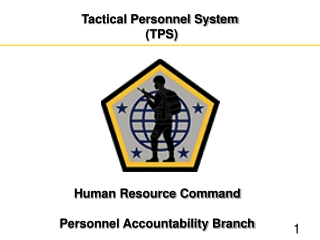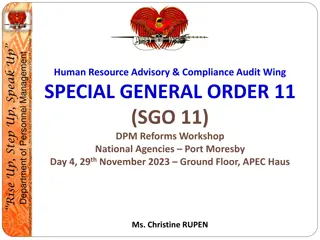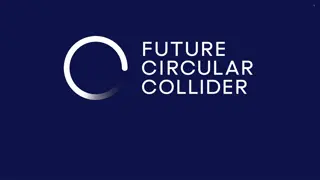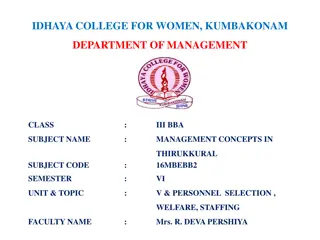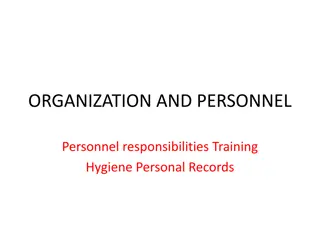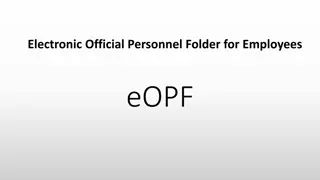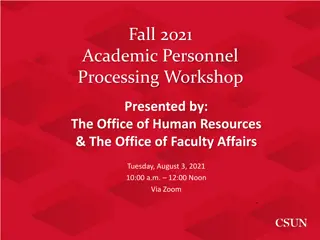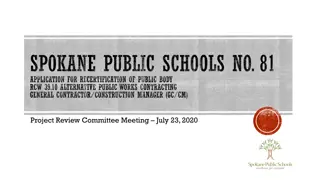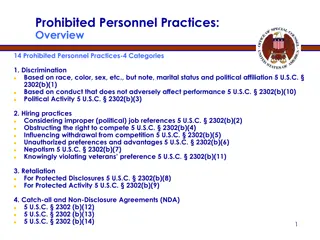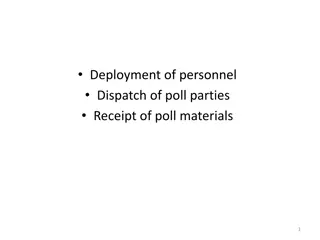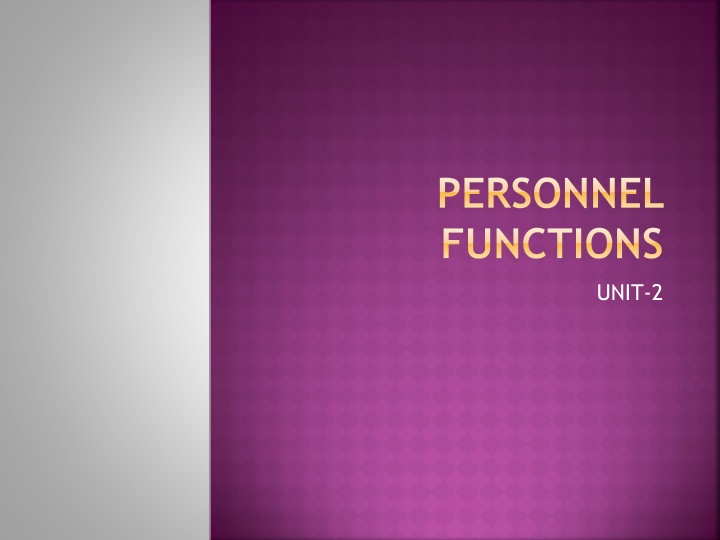
Personnel Functions in Organizations: Managerial, Operative, and General Functions Explained
Learn about the key personnel functions in organizations, including Managerial Functions (Planning, Organizing, Directing, Coordinating, Controlling), Operative Functions (Procurement, Development, Compensating, Maintenance, Integrating, Separation), and General Functions (Employment, Promotion, Training, Wages, Collective Bargaining). Understand the importance of planning, organizing, directing, and coordinating in effective management practices. Explore the roles and responsibilities involved in human resource management and organizational development.
Download Presentation

Please find below an Image/Link to download the presentation.
The content on the website is provided AS IS for your information and personal use only. It may not be sold, licensed, or shared on other websites without obtaining consent from the author. If you encounter any issues during the download, it is possible that the publisher has removed the file from their server.
You are allowed to download the files provided on this website for personal or commercial use, subject to the condition that they are used lawfully. All files are the property of their respective owners.
The content on the website is provided AS IS for your information and personal use only. It may not be sold, licensed, or shared on other websites without obtaining consent from the author.
E N D
Presentation Transcript
PERSONNEL FUNCTIONS UNIT-2
PERSONNEL FUNCTIONS A: The Managerial Functions:- 1. Planning 2. Organizing 3. Directing 4. Co-Ordinating and Controlling. B: The Operative Functions:- 1. Procurement 2. Development 3. Compensating 4. Maintenance 5. Integrating and 6. Separation. C: General Functions:- 1. Employment 2. Promotion, Transfer and Termination 3. Training 4. Wages and Other Incentives 5. Service Activities and Collective Bargaining Employees Representation.
MANEGERIAL FUNCTION i. Planning: Is a predetermined course of action. According to Allen, it is a trap laid to capture the future. Terry is of the view that planning is the foundation of most successful actions of any enterprise. Planning is the determination of the plans, strategies, programmes, policies, procedures, and standard needs to accomplish the desired organisational objectives. In fact, planning today avoids crisis tomorrow.
MANEGERIAL FUNCTION ii. Organising: After a course of action has been determined, an organisation should be established to carry it out. According to J.C. Massie, An organisation is a structure, a framework and a process by which a cooperative group of human beings allocates its tasks among its members, identifies relationships and integrates its activities towards common objectives.
MANEGERIAL FUNCTION iii. Directing: Directing the subordinates at any level is a basic function of the managerial personnel. According to McGregor, many managers would agree that the effectiveness of their organisation would be at least doubled if they could discover how to tap the unrealised potential present in their human resources.
MANEGERIAL FUNCTION iv. Co-Ordinating and Controlling: Co-ordinating refers to balancing timing and integrating activities in an organisation, so that a unity of action in pursuit of a common purpose is achieved. In the words of Terry, Co-ordination deals with the task of blending efforts in order to ensure a successful attainment of an objective. Co- ordination in the management of personnel takes place at all levels, from the top management through to the supervisor and those for whom he is responsible.
OPERATIVE FUNCTION i. Procurement Function: The procurement function is concerned with the obtaining of a proper kind and number of personnel necessary to accomplish an organisation s goals. It deals specifically with such subjects as the determination of manpower requirements, their recruitment, selection and place (comprising activities to screen and hire personnel, including application-forms, psychological tests, interviews, medical check- up reference calling), induction, follow-up, transfers, lay-offs, discharge and separation, etc.
OPERATIVE FUNCTION i. Procurement Function a. Job Analysis: Organisations consist of jobs that have to be staffed. Job analysis is the procedure through which the Personnel Manager determines the duties and responsibilities of these jobs and the characteristics of the people to hire for them. b. Manpower Planning: It is the process of deciding what positions the firm will have to fill and how to fill them. It is a process of analysing the present and future vacancies that may occur as a result of retirements, discharges, transfers, promotions, sick leave, leave of absence, or other reasons, and an analysis of present and future expansion or curtailment in the various departments. Plans are then formulated for internal shifts or cut-backs in manpower, for the training and development of present employees, for advertising openings, or for recruiting and hiring new personnel with appropriate qualifications. c. Recruitment: It is concerned with the process of attracting qualified and competent personnel for different jobs. This includes the identification of existing sources of the labour market, the development of new sources, and the need for attracting large number of potential applicants so that a good selection may be possible.
OPERATIVE FUNCTION i. Procurement Function . Selection: Selection process is concerned with the development of selection policies and procedures and the evaluation of potential employees in terms of job specifications. This process includes the development of application blanks, valid and reliable tests, interview techniques, employee referral systems, evaluation and selection of personnel in terms of job specifications, the making up of final recommendations to the line management and the sending of offers and rejection letters. e. Placement: It is concerned with the task of placing an employee in a job for which he is best fitted, keeping in view the job requirements, his qualifications and personality needs. f. Induction and Orientation: Induction and orientation are techniques by which a new employee is rehabilitated in his new surroundings and is introduced to the practices, policies and people. The new recruit is introduced to the principles which define and drive the organisation, the mission statement and values which form its backbone. g. Internal Mobility: It is the movement of employees from one job to another through transfers and promotions. Transfer process is concerned with the placement of an employee in a position in which his ability can be best utilised. This is done by developing transfer policies and procedures, counseling employees and line management on transfers and evaluating transfer policies and procedures.
OPERATIVE FUNCTION ii. Development Function: a. Training: It is complex process and is concerned with increasing the capabilities of individuals and groups so that they may contribute effectively to the attainment of organisational goals. b. Executive Development: It is a systematic process of developing managerial skills and capabilities through appropriate programmes. c. Career Planning and Development: Career may be defined as the occupational positions a person has had over many years. Career Planning is the planning of one s career and implementation of career plans by means of education, training, job search and acquisition of work experiences.
OPERATIVE FUNCTION iii. Compensating Function: The compensating function is concerned with securing adequate and equitable remuneration to personnel for their contribution to the attainment of organisational objectives. Functions related to wage surveys, establishment of job classifications, job descriptions and job analyses, merit ratings, the establishment of wage rates and wage structure, wage plans and policies, wage systems, incentives and profit- sharing plans, etc., fall under this category.
OPERATIVE FUNCTION iv. Maintenance Function: The maintenance function deals with sustaining and improving the conditions that have been established. Specific problems of maintaining the physical conditions of employees (health and safety measures) and employee service programmes are the responsibility of the personnel department.
OPERATIVE FUNCTION iv. Maintenance Function: a. Health and Safety: Personnel Managers must take care of all statutory provisions governing the health and safety of employees. They must ensure a work environment that protects employees from physical hazards, unhealthy working conditions and unsafe acts of other personnel. Through proper safety and health programmes, the physical and psychological well-being of employees must be preserved and even improved. b. Employee Welfare and Social Security Measures: Employee welfare includes the services, amenities and facilities offered to employees within or outside the establishment for their physical, psychological and social well-being. Housing, transportation, education and recreation facilities are all included in the employee welfare package. Managements provide social security to their employees in addition to fringe benefits. These measures include: (1) Workmen s compensation to those workers (or their dependents) who are involved in accidents; (2) Maternity benefits to women employees; (3) Sickness benefits and medical benefits; (4) Disablement benefits/allowance; (5) Dependent benefits; (6) Retirement benefits like Provident Fund, Pension, Gratuity, etc.
OPERATIVE FUNCTION v. Integrating Function: The integration function, after the employee has been procured, his skill and ability developed and monetary compensation determined, the most important, yet difficult of the personnel management is to bring about an integration of human resources with organisation, and to cope with inevitable conflicts that ensue.
OPERATIVE FUNCTION v. Integrating Function: a. Grievance Handling: A grievance is any factor involving wages, hours or conditions of employment that is used as a complaint against the employer. Constructive grievance handling depends first on the manager s ability to recognise, diagnose and correct the causes of potential employee dissatisfaction before it converts into a formal grievance. b. Discipline: It is the force that prompts an individual or a group to observe the rules, regulations and procedures, which are deemed necessary for the attainment of an objective. c. Trade Unions: A Trade union is an association either of employees or employers or independent workers. It is a relatively permanent body formed by workers, generally speaking, with the primary objective of countering exploitation and harassment.
OPERATIVE FUNCTION Integrating Function: d. Collective Bargaining: It is the process of agreeing on a satisfactory labour contract between management and union. The contract contains agreements about conditions of employment such as wages, hours, promotion, and discipline; lay- offs, benefits, vacations, rest pauses and the grievance procedure.
OPERATIVE FUNCTION Integrating Function: e. Industrial Relations: Harmonious industrial relations between labour and management are essential to achieve industrial growth and higher productivity. When the relationship between the parties is not cordial, discontentment develops and conflicts erupt abruptly. It is not always easy to put out the fires with the existing dispute-settlement machinery, created by the government. Hence, both labour and management must appreciate the importance of openness, trust and collaboration in their day-to-day dealings
PAYMENT OF WAGES Wage payment system consists of the pay structures and the methods used to motivate and reward work force for their contribution to the goals of the organisation. Various systems of the wage payments have been developed in different industries and in different countries. The various systems and methods of wage payment are:- 1. Time Wage System 2. Piece Wage System 3. Payment by Results (PBR) 4. Balance or Debt Method 5. Incentive Rate System.
PAYMENT OF WAGES 1. TIME WAGE
PAYMENT OF WAGES 1. Time Wage: Time wage system is also called day wage system is a system in which wages are paid on the basis of time spent by the worker like per day, week or month instead of output produced or amount of work done. Here presence of employee is more important than performance of employee. The wage rate is determined by negotiation considering prevailing local wage rate or job evaluation.
PAYMENT OF WAGES Time Wages Merits or Advantages: (i) Simple and easy This method is simple and easy to calculate remuneration by both workers and employers as unit of output produced need not be counted and recorded. (ii) Improves quality of work This method ensures improved quality of work as there is no pressure on workers to speed-up production and there is every scope for the workers to show their talent and skill. (iii) Economical Clerical work in computation of wages is minimum and there is no necessary of keeping records for the units produced and hence it is less expensive. (iv) It assures fixed remuneration to workers As remuneration is paid on the basis of time spent rather than unit produced, workers get fixed remuneration for the number of days they have attended irrespective of the amount of work done. (v) Encourages beginners It encourages beginner or learner to learn best method of doing work as their earnings are not related to unit produced.
PAYMENT OF WAGES Time Wage Demerits or Disadvantage: (i) No distinction between efficient and inefficient employees This system does not make any difference between efficient and inefficient employees as efficient and hardworking employees receive the same remuneration at par with inefficient employees. (ii) This system is a punishment to efficient employees Efficient and hardworking employees do not get extra remuneration in spite of their extra effort and performance. Therefore, this system does not attract and encourage hardworking and efficient employees . (iii) No increase in production Under this system remuneration is paid on the basis of time spent by the workers rather than unit produced and hence there is no pressure to speed up production which in turn may result decrease in production. (iv) Difficult to calculate labour cost As remuneration is paid on the basis of time spent and not on the basis of unit produced, calculation of labour cost per unit is difficult.
PAYMENT OF WAGES Time Wage Demerits or Disadvantage: (v) Low productivity and high supervision cost As the system does not offer any incentive to efficient and hardworking employees, productivity of labour becomes low unless close supervision is used which in turn increases cost of supervision. (vi) Difficult to ascertain the merit As all employees are treated at par, there is no basis for finding the merit of different employees. (vii) Difficult to fix the basis of promotion As it is difficult to find out the merit of employees, it is also difficult to fix the basis of promotion. If the employees are promoted on the basis of seniority, it may affect on the morale and efficiency of young and hardworking employees.
PAYMENT OF WAGES Suitability of Time Wage System: Time wage system is suitable under the following circumstances: i. Where quality of work is important rather than quantity to be produced. E.g. Jeweler, furniture etc. ii. Where workers are new, learner or beginner. iii. Where output cannot be measured in terms of individual unit produced by each employee. iv. Where machinery and equipment used in the process of production are sophisticated, expensive and need special care. v. Where employees have little or no control over quantity of output to be produced.
PAYMENT OF WAGES 2. Piece Wages
PAYMENT OF WAGES 2. Piece Wage: In this system of wage payment, remuneration is paid to the employees on the basis of unit produced or amount of work done. Unit of output produced or amount of work done is the basis of payment of wages. Therefore, greater is the number of unit produced, higher is the remuneration of employees and vice-versa, hence this method is called payment by result. Under this system efficient and hardworking employees get higher remuneration whereas learner or beginner gets lower amount of remuneration.
PAYMENT OF WAGES Merits or Advantages of Piece Wage System: (i) Attracts efficient and hardworking employees As remuneration is paid on the basis of units produced or amount of work done, efficient and hardworking employees work more and show better performance that in turn get higher remuneration. (ii) Increase in production and productivity As workers are paid remuneration on the basis of their performance, workers are forced to work more and to show better performance which in turn increase production and may also increase productivity. (iii) Low cost of production Increase in productivity and production may result in lower cost of production per unit.
PAYMENT OF WAGES Merits or Advantages of Piece Wage System: (iv) Simple and easy to calculate wages As wages are paid directly in proportion to the number of unit produced, calculation of wage or remuneration is easy. Even employees themselves can calculate their remuneration on the basis of unit produced and rate per unit. (v) Increase in standard of living of employees Efficient and hardworking employees have opportunity to show their talent and increase their earnings which in turn help them to improve their standard of living. (vi) Helps in fixing the basis of promotion Piece wage system helps the management in distinguishing efficient and inefficient employees which help them in giving the promotion to employees.
PAYMENT OF WAGES Demerits or Disadvantages: Piece wage system suffers from the following drawback: (i) Effect on quality of output In the race to earn more wages, workers may work fast and may not give importance to the quality, which may affect on image of the business. (ii) Variation in the earnings of the workers Workers earnings depend on their working performance. Higher is the performance, better will the remuneration and vice-versa. In view of variation in earnings workers may feel insecure and dissatisfied. (iii) Difficult to fix wage rate Unless scientific basis is made available to fix the wage rate, employers may find it difficult to fix suitable piece rate. Piece rate, if fixed arbitrarily, may be harmful either to employer or to employees
PAYMENT OF WAGES Piece Wage Demerits or Disadvantages: (iv) Expensive and time consuming Detailed record of production, involves clerical work. Continuous production requires continuous recording of work for calculation of piece wage which is both expensive and time consuming. (v) No guarantee of minimum wage This method does not guarantee minimum wage and hence Trade Union may not accept this method of wage payment. (vi) Disparity between employees This method makes difference between efficient and in-efficient workers as efficient workers work more and earn more income as compared to inexperienced and inefficient workers. Therefore, this method may create jealousy among the workers and may spoil the industrial relation also.
PAYMENT OF WAGES Suitability of the Method: Piece wage system is suitable under the following circumstances: (i) Where there is an urgency to increase the production and quality is not that much important. (ii) Where it is possible to measure the units produced by an individual worker separately. (iii) Where the quality of the output depends on skill and judgment of the employees. (iv) Where there is regularity in flow of work and interruptions are minimum. (v) Where method of production is standardized and the job is of a repetitive nature.
PAYMENT OF WAGES 3. Payment by result
PAYMENT OF WAGES 3. Payment by Results (PBR): There are many different systems of wage payment under which the worker s earnings are related directly to some measurement of the work done either by himself or by the group or working unit to which he belongs. Such systems, known as payment by results, can be classified in four main groups such as- (i) in the same proportion as output; (ii) proportionately less that output; (iii) proportionately more than output; or (iv) in proportions which differ at different levels of output.
PAYMENT OF WAGES The PBR may be introduced with certain safeguards such as: (a) Quality of output is to be controlled through strict supervision; (b) Wastage of material is to be prevented; (c) Health of the worker is to be protected; (d) Supply of raw materials, maintenance of plant and efficiency of management are to be assured; (e) Workers are to be guaranteed job security or continued employment; and (f) Work-load is to be fixed by impartial aspects.
PAYMENT OF WAGES The PBR has many advantages: (a) It pays the workmen according to their efficiency as reflected in the amount of work turned out by them; (b) It involves less supervision as the workers are not likely to while away their time; (c) Being interested in the continuity of his work, a workman is likely to take greater care in the maintenance of the machine.
PAYMENT OF WAGES The demerits of PBR system are: (a) A piece rate worker in his anxiety to produce more may neglect the quality of output; (b) He may, in his desire to earn more, may work so hard as to impair his health, unmindful of the fact that this would ultimately reduce his earning power; (c) Under this system, the worker s earning may suffer because of causes beyond his control, such as inadequate supply of raw materials, failure of machinery, lack of demand in the market for the goods produced; (d) Trade unions are often opposed to this system as they are of the opinion that such a system encourages rivalry among workers and endangers their solidarity in labour disputes.
PAYMENT OF WAGES 4. Balance or Debt Method
PAYMENT OF WAGES 4. Balance or Debt Method: This is a combination of time and piece rate. The worker is guaranteed an hourly or a day rate with an alternative piece rate. If the earnings of a worker calculated at the piece rate exceeds the amount which he would have earned if paid on the time basis, he gets credit for the balance, namely, the excess piece rate earnings over the time rate earnings.
PAYMENT OF WAGES 5. Incentive Rate
PAYMENT OF WAGES 5. Incentive Rate: Incentive Rates can be used more effectively in a production situation where output is measurable in homogeneous units, where product specifications do not change frequently, and where worker s effort can directly influence output. Incentives are difficult to employ where output is fixed substantially by the requirements of production process and cannot be controlled by the workers.
PAYMENT OF WAGES Advantages of Incentive Wage System: i. There is increase in the prospect of workers to earn more. As shown by F. Herzberg good salary is one of the hygiene factors in the absence of which people are unhappy and dissatisfied. Wage incentive offers them the prospect of earning more. ii. The scientific work study which is done before introducing a wage incentive plan brings about improvements in methods, workflow, and man-machine relationship and so on. iii. There is effective reduction in the supervision costs Closer supervision of employees becomes unnecessary because workers become more responsible. Rather than the supervisor chasing the workers the workers themselves sometimes chase the supervisor for materials, tools, etc.
PAYMENT OF WAGES Advantages of Incentive Wage System: iv. Employees promptly expose all such problems before management which retard their earnings. Management becomes more alert in areas such as flow of process materials, adequate spares, etc. v. Employees are encouraged to become inventive . They invent and adopt ways and means to achieve their production targets with lesser exertion and lesser expense of energy. They come forward with new ideas and suggestions. vi. There is improvement in discipline and industrial relations. Go-slow and similar other techniques are not resorted to by the workers to express their dissatisfaction with management policies and practices. There is increase in workers punctuality and decrease in absenteeism. vii. There develops a feeling of mutual co-operation among the workers as their operations are interdependent and any hold-up at one point may affect the production and earning at other points.
PAYMENT OF WAGES Disadvantages of Incentive Wage System i. There is tendency among the workers to sacrifice quality for the sake of quantity. This calls for a very strict system of checking and inspection. ii. In the absence of adequate provisions incentive payment brings about certain rigidity in the operations. This makes it difficult for the management to revise norms and rates following changes in technology, methods, machines, materials etc. iii. Employees very often ask for compensation whenever production flow is disrupted due to the fault of management.
PAYMENT OF WAGES Disadvantages of Incentive Wage System iv. Unless greater vigilance is exercised there is a danger of workers disregarding safety regulations. v. Unless a maximum ceiling on incentive earning is fixed some workers tend to overwork and undermine their health. vi. Jealousies may arise among workers because some are able to earn more than others. In the case of group systems, the fast workers may be dissatisfied with the efforts of the slower members of the group; where heavy work is involved older workers in particular are likely to be criticised for being too slow. One likely effect of this is the splitting up of trade unions.


